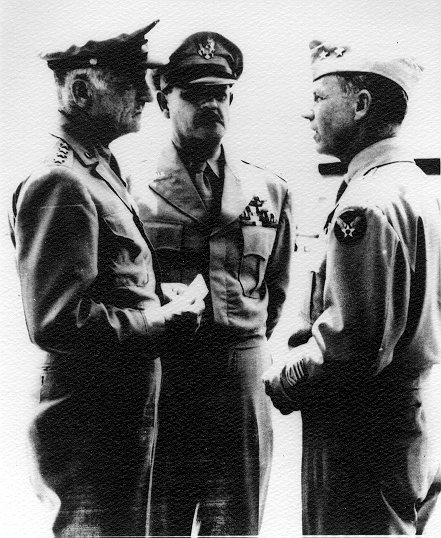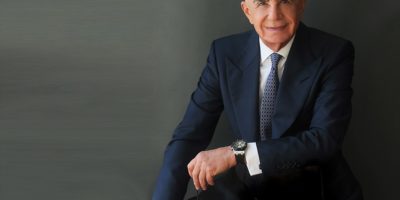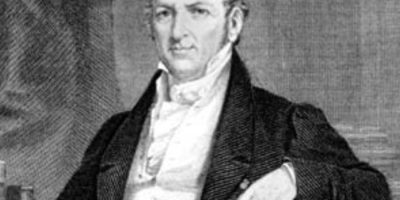
From left, General Carl A. Spaatz, Commanding General, Army Air Forces; Major General Muir S. Fairchild, AU commander; and Major General Donald M. Wilson, Commanding General, of Air Proving Ground Command. Photo from Wikimedia
Top 10 Facts about the Bomber Mafia
The Bomber Mafia was a close-knit group of American military men who believed that large numbers of long-range heavy bomber aircraft could win a war. The derogatory term “Bomber Mafia” was used before and after World War II by those in the military who did not share their belief and were frustrated by the men’s insistence that the heavy bomber take priority in planning and funding.
The bomber mafia achieved their goal of having large bomber fleets in the US military, but they failed to achieve pinpoint targeting precision during WWII. Instead, the bomber fleets played a significant role in the overall American war effort, aiding in the reduction of enemy fighting power, particularly in Japan, where they destroyed the largest cities by switching to area incendiary bombing tactics.
Following the war, the bomber mafia’s 20-year foundational work resulted in the separation of the United States Air Force from the Army to become an independent military arm. The strategic doctrine of the bomber mafia, shaped by war and experience, helped shape the mission of the new Air Force and its Strategic Air Command.
1. The Bomber Mafia had four instructors who served as its backbone
Brigadier General William “Billy” Mitchell, who advocated a greatly expanded role for the bomber force, developed a forward-thinking doctrine of daylight precision bombing at the Air Corps Tactical School (ACTS) at Langley Field in Virginia between 1926 and 1929.
After graduating from ACTS in 1931, Mitchell protégée Harold L. George stayed on to refine and teach the new bombing theory, quickly recruiting former students Haywood S. Hansell, Donald Wilson, and Laurence S. Kuter as teachers.
These four instructors, who formed the backbone of US bomber advocacy.
2. They insisted that precision bombing was a morally acceptable method of destroying an enemy’s fighting capability

Aircraft flying through smoke. Photo by Edgar Serrano. Unsplash
The four instructors argued that by destroying industrial and military targets deep within enemy territory, an enemy’s army and navy could be defeated intact. This theory was first advocated by Italian General Giulio Douhet, though his ideas included terror bombings of population centres, which American theorists rejected.
In contrast, American theorists devised a strategy of pinpoint bombing that targeted the enemy’s economy and weapons production. Though unproven, the main appeal of this type of strategic bombing doctrine was that a war could be won relatively quickly and with few casualties, avoiding the grinding, static trench warfare seen in World War I.
When British Lord President of the Council Stanley Baldwin said in November 1932, “the bomber will always get through,” he was referring to the terror bombing of cities. The US Bomber Mafia only agreed with Baldwin on one point: the bomber would succeed in its mission. They intended for the mission to be directed at military and industrial targets rather than civilians.
3. Carl Norden made precision bombing possible

Norden MK XI Bomb sight Prototype. Photo by Sanjay ach. Wikimedia
The invention of a bomb sight by Dutch engineer Carl Norden, which allegedly allowed a bombardier to drop a missile into a pickle barrel from six miles up, had made precision bombing possible.
4. The Bomber Mafia needed to rack up a fleet of planes and aircrew
To put this doctrine into action, the US Army Air Corps would need to spend the majority of its resources amassing a fleet of self-defending heavy bombers, as well as training and maintaining numerous airmen to fill aircrew and ground crew positions.
The ACTS officers who believed in the heavy bomber doctrine understood that any other Air Corps expenditures, such as tactical bombers and fighter planes, would detract from the proposed large fleet of heavy bombers.
Furthermore, the men realized that in order to build a large air fleet, the US government would have to reduce funding for naval and ground forces.
To effect these changes, ACTS instructors began to instil in their students the belief that a separate and independent air arm of the type described earlier by Mitchell, to be known as the United States Air Force, was the way forward.
In 1935, the Army Air Corps established the General Headquarters (GHQ) Air Force, commanded by General Frank M. Andrews, a proponent of strategic bombing. Andrews staffed the command with officers who shared his values.
5. Members of the Bomber Mafia produced two warplanes

A warplane. Photo by Cpl Lee Goddard. Wikimedia
Although precision bombing was flawed and tested only under ideal conditions, the doctrine became the United States’ primary airpower strategy in World War II planning. Members of the “Bomber Mafia” produced the two aircraft.
Members of the “Bomber Mafia” created the two airpower war plans (AWPD-1 and AWPD-42) that guided the Army Air Forces’ wartime expansion and deployment.
6. The term “Bomber Mafia” arose from heated debates between US Army and Air Corps staff
The term “Bomber Mafia” arose from sometimes heated debates between United States Army staff and Air Corps men who observed and argued with instructors and students of the ACTS who insisted that heavy bombers were the new primary weapon of war and that they needed to be commanded by a separate air arm.
7. George C. Kenney was the Bomber Mafia’s most outspoken critic

George C. Kenney. Photo by U.S. Air Force. Wikimedia
For the first few years, the most vocal opponent of the bomber doctrine at ACTS was Captain (later General) George C. Kenney, who advocated using air power to attack enemy fighting units on the ground.
He advocated for close air-ground coordination, with a focus on medium bombers and fighter bombers. Kenney left ACTS in 1929, and the vacancy was filled by heavy bomber doctrinaires. The doctrine also contradicted Billy Mitchell’s theories, which held that pursuit support was essential for daylight bombing operations.
8. The Bomber Mafia’s career peaked in 1943 with two raids on Germany
The first raid was a diversion meant to draw off the fighters that would inevitably attack any large formation of Allied bombers, and it targeted the Messerschmitt aircraft factory in Regensburg. If the Messerschmitt plant could also be destroyed, that would be ideal.
The main effort, however, was a slightly later-in-the-day raid on a ball bearing factory in Schweinfurt—exactly the kind of industry-crippling target the Mafia had developed their ideas around. Following weather delays, the two missions launched, now several hours apart, giving the Germans plenty of time to regroup and attack again.
9. The Bomber Mafia’s theory was proven incorrect during WWII
The Bomber Mafia’s theory of the primacy of unescorted daylight strategic bombing was proven incorrect during WWII. Heavy bomber fleets could not win without the cooperation of the Army and Navy, and deep penetration missions required the protection of long-range fighters.
The war’s overall casualties were not insignificant, and victory did not come quickly. Precision bombing did not become possible until long-range fighter escorts and air superiority were available, as opponents had predicted.
The strategic bombing concept, on the other hand, played a significant role in the eventual victory and became the first core doctrine of the independent United States Air Force.
Proponents of the doctrine continued to promote it into the Atomic Age, forming the Strategic Air Command to carry out a vision modified to fit the needs of the Cold War and the threat of nuclear warfare. In the 1950s and 1960s, supporters of intercontinental ballistic missile warfare gradually displaced the Bomber Mafia.
10. Malcolm Gladwell wrote a book on the Bomber Mafia

Malcolm Gladwell. Photo by Kris Krüg. Wikimedia
Malcolm Gladwell wrote in his 2021 popular history book The Bomber Mafia that the idea of precision bombing remained alive in the US military, with greater accuracy obtained with guided bombs from the 1990s to the present, such that a modern laser-guided bomb or missile might be expected to destroy not just a single building but a single room within the building, minimizing collateral damage.
Gladwell opined that Haywood Hansell’s moralistic, casualty-avoidance ideas remained relevant for many years while the high death toll of area bombing fell out of favour. Gladwell wrote that Hansell “won the war” in this sense.
Planning a trip to Paris ? Get ready !
These are Amazon’s best-selling travel products that you may need for coming to Paris.
Bookstore
- The best travel book : Rick Steves – Paris 2023 – Learn more here
- Fodor’s Paris 2024 – Learn more here
Travel Gear
- Venture Pal Lightweight Backpack – Learn more here
- Samsonite Winfield 2 28″ Luggage – Learn more here
- Swig Savvy’s Stainless Steel Insulated Water Bottle – Learn more here
Check Amazon’s best-seller list for the most popular travel accessories. We sometimes read this list just to find out what new travel products people are buying.









